November 6. POLONNARUWA The guesthouse sorted out a tuk-tuk to take us to the bus station in the morning. The guy didn't speak much English but the guesthouse told him we wanted the bus to Polonnaruwa. It didn't end up helping since he put us on a bus to Anuradhapura instead.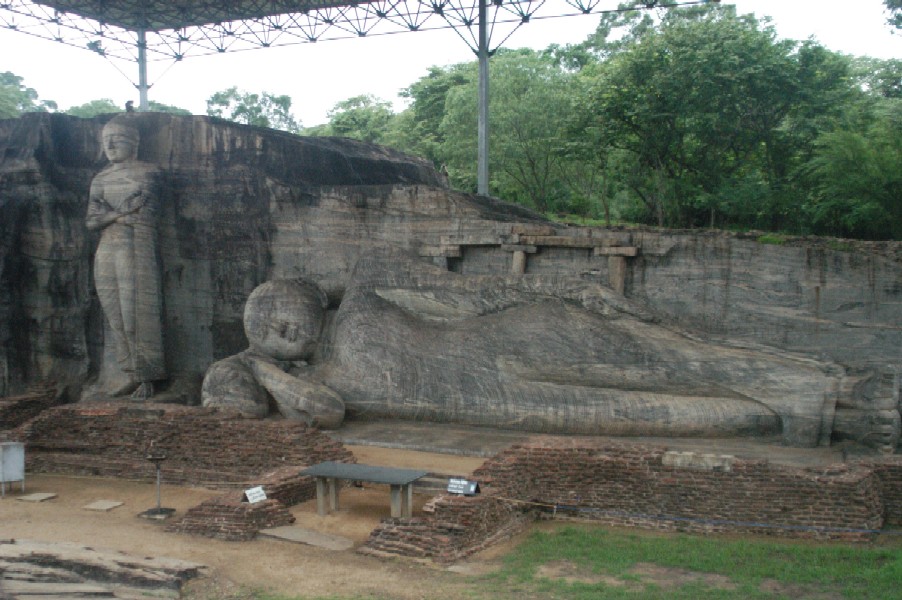 Fortunately we checked before the bus left. We found a local bus to Polonnaruwa and it looked like it was our only option but finally Rob found a small A/C bus that was direct. I stayed on the first bus with our bags while he dodged through the rain and tried to make out where the buses were going. Naturally the bus station was chaotic. While I was sitting there a young woman sitting behind started to talk to me. I thought it was so nice at first but only a couple of questions into the conversation and we got to "Can I have your address?". Why would I give my address to someone I'd only just met? Did that really work on some tourists? I just pretended not to understand and fortunately Rob came and dragged me to the next bus. Fortunately we checked before the bus left. We found a local bus to Polonnaruwa and it looked like it was our only option but finally Rob found a small A/C bus that was direct. I stayed on the first bus with our bags while he dodged through the rain and tried to make out where the buses were going. Naturally the bus station was chaotic. While I was sitting there a young woman sitting behind started to talk to me. I thought it was so nice at first but only a couple of questions into the conversation and we got to "Can I have your address?". Why would I give my address to someone I'd only just met? Did that really work on some tourists? I just pretended not to understand and fortunately Rob came and dragged me to the next bus.
It was a rollicking three hour bus ride to Polonnaruwa, breaking and weaving the entire way. Polonnaruwa was the capital of the Sinhalese (early Sri Lankan inhabitants, probably from north India) and Chola (south Indian) kingdoms. The Chola dynasty first made its capital at Polonnaruwa after conquering the Sinhalese capital of Anuradhapura, farther north. In 1070 the Sinhalese drove the Cholas off of the island and kept Polonnaurwa as their capital. We opted to just visit Polonnaruwa since the ruins at Anuradhapura are older and in a more serious state of ruin. There 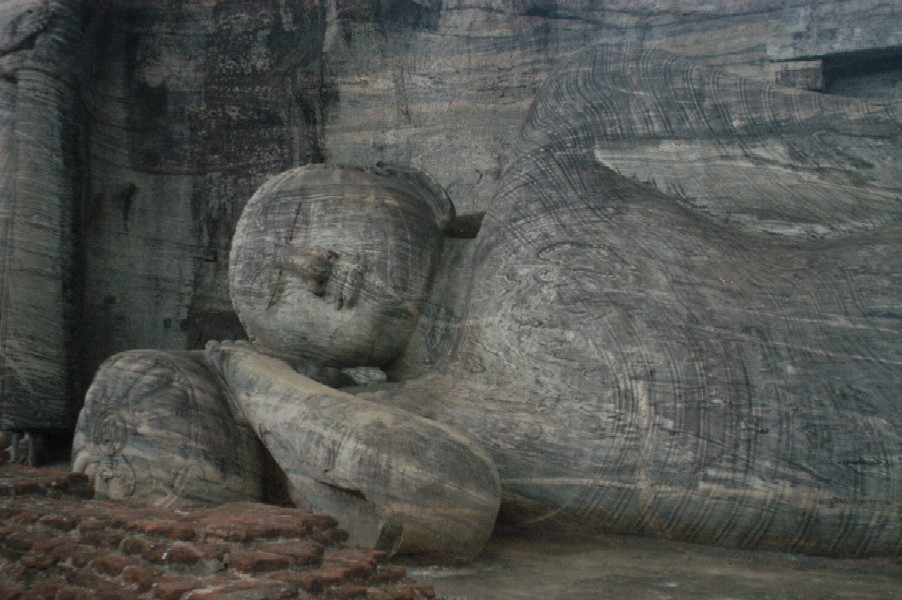 wasn't much to the town of Polonnaruwa. The bus dropped us near the entrance to the ruins and we checked into a hotel we had booked by phone from Kandy, the Gajaba Hotel. It was poor value for the money, especially after the McLeod Inn, but it was fine for a night. We tried to get some lunch but they were out of everything so we gave up and just headed off to see the ruins. It was getting late and the weather was looking ominous. A tuk-tuk had been stalking us from the bus stop but we dodged it by going into the museum. wasn't much to the town of Polonnaruwa. The bus dropped us near the entrance to the ruins and we checked into a hotel we had booked by phone from Kandy, the Gajaba Hotel. It was poor value for the money, especially after the McLeod Inn, but it was fine for a night. We tried to get some lunch but they were out of everything so we gave up and just headed off to see the ruins. It was getting late and the weather was looking ominous. A tuk-tuk had been stalking us from the bus stop but we dodged it by going into the museum.
The Polonnaruwa museum was excellent. It was small but well laid out and very informative. We would have like to have spent more time but on our tight schedule we couldn't afford it. When we emerged from the museum the same tuk-tuk was still waiting. At this point I was nearly ready to punch the guy. We just started off walking towards the main entrance to the ruins and eventually got the guy to go away. We really did need a tuk-tuk but neither of us wanted that one. Near the gate there were a couple more queued up and Rob negotiated with one of them to take us around the ruins. It was looking a lot like rain and there was a lot of ground to cover. Our first stop was just inside the gate at the Royal Palace but while we were checking out the ruins it started to rain. We climbed back into the tuk-tuk and just told him to take us to the Gal Vihara, a group of Buddhas carved into one long slab of granite rock, the highlight of Polonnaruwa.
Gal Vihara was in the north of the vast grounds that stretched several kilometers. Touted as the pinnacle of Sinhalese rock carvings the Buddhas are now covered under crude metal canopies, courtesy of UNESCO. Perhaps it was good that they were finally being protected but after nearly 1000 years it seemed sad to obscure the beautiful images under such ugly structures. As we approached the statues a guard made us remove our shoes out of respect. The area was just gravel and it was wet outside but that didn't matter. Naturally we had left our sandals in Kandy when we pared down our belongings to 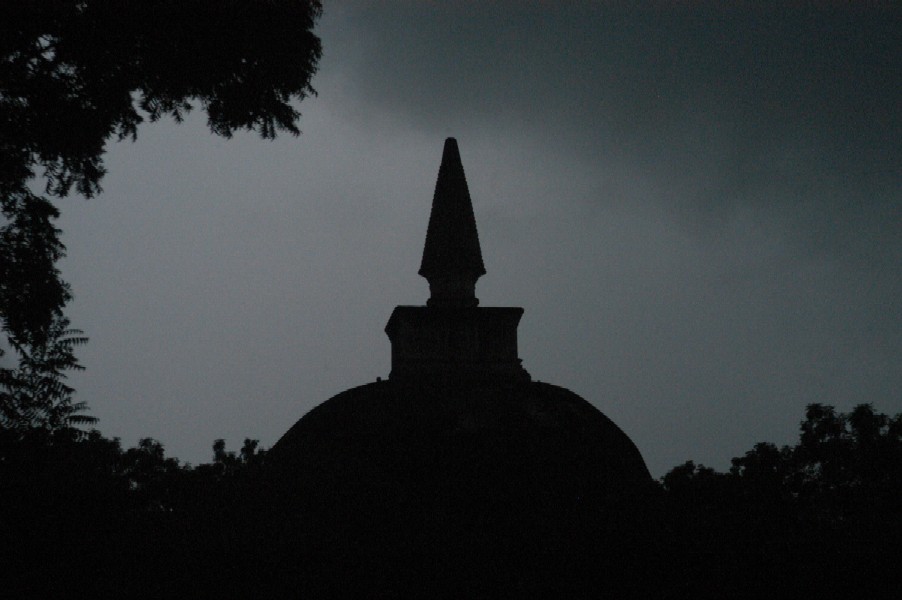 just daypack. We just had our tennis shoes with us, more practical for climbing Sigiriya we had thought, but they weren't very practical for temple going. The two most outstanding images were one standing Buddha, about 7m high, and a larger reclining Buddha, about 14m long. The two smaller sitting Buddhas were hidden behind scaffolding. After a good long look we grabbed our shoes and climbed back in our tuk-tuk. just daypack. We just had our tennis shoes with us, more practical for climbing Sigiriya we had thought, but they weren't very practical for temple going. The two most outstanding images were one standing Buddha, about 7m high, and a larger reclining Buddha, about 14m long. The two smaller sitting Buddhas were hidden behind scaffolding. After a good long look we grabbed our shoes and climbed back in our tuk-tuk.
Our next stop was the Tivanka Image House, still farther north. We hadn't been back in the tuk-tuk very long when the rain just started pouring down. We paused to north of the massive Rankot Vihara dagoba, after the three great dagobas in Anuradhapura it was the largest in Sri Lanka, standing 55m high. It was getting dark so we saw more of a silhouette. There was a sort of picnic area nearby with a snack stand and bathrooms. The curios booths were shutting up quickly as the rain picked up and oddly enough there was a small herd of goats that had lined themselves up under the awning of the toilet block. Head to toe and toe to head they were all flat against the wall, trying to keep away from the rain. Goats are odd animals. I had to think back to the goats in a tree that we had seen in Morocco. They were like the Farside come to life.
After arriving at the Image House we waited for the rain to subside. It didn't so we threw on our ponchos and ran to the entrance. We were almost glad that this building was covered until a metal roof. It was meant to have a roof but the original was long gone and the images inside were in need of the extra protection. Unfortunately it was almost too dark to see the interior. Of course the shoes came off 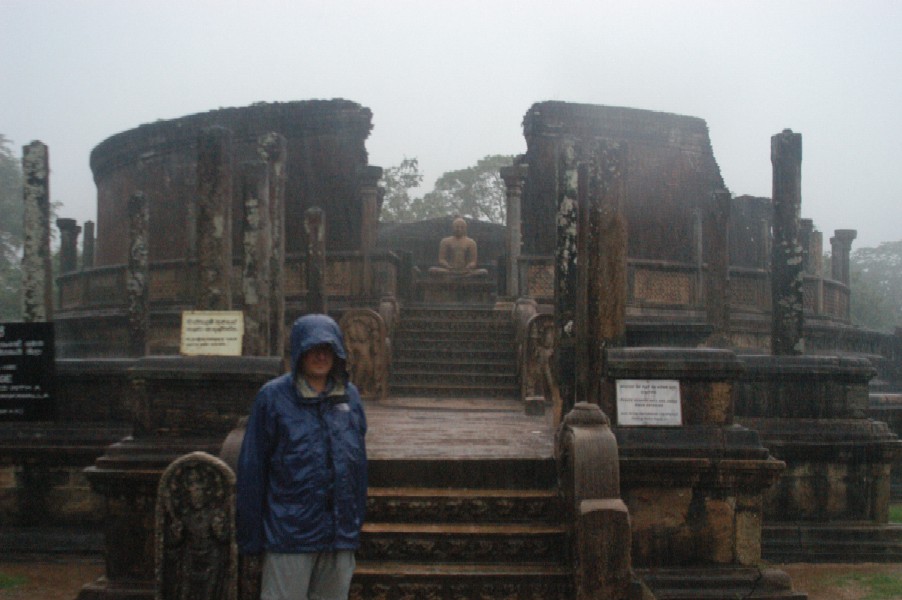 again but at least the stone floor was relatively dry this time. The Tivanka Image House contained the only frescos to survive in all of Polonnaruwa and after 1000 years it is amazing that any survived at all. The long narrow building was lit by candles at the end of the hall and little white flowers had been laid out on a table in the shape of a stupa. The exterior of the building was meant to have had some fine carvings as well but we didn't venture that far. We were already dripping wet by the time we ran back to the tuk-tuk. again but at least the stone floor was relatively dry this time. The Tivanka Image House contained the only frescos to survive in all of Polonnaruwa and after 1000 years it is amazing that any survived at all. The long narrow building was lit by candles at the end of the hall and little white flowers had been laid out on a table in the shape of a stupa. The exterior of the building was meant to have had some fine carvings as well but we didn't venture that far. We were already dripping wet by the time we ran back to the tuk-tuk.
The whole Polonnaruwa sightseeing endeavor was becoming rather worthless. But we had paid for our ticket and this was the only day we had so we tried to make the best of it. Our driver was an accommodating fellow and sped along the dirt roads to get us from place to place as quickly as possible. He even tried to position the tuk-tuk along the road so we could view the large Rankot Vihara dagoba without getting out. For the Quadrangle we did get out one last time. A walled in area that stood a flight of stairs above the ground, the Quadrangle housed several smaller temples. The rain was pouring down but we still had to take our shoes off to enter the temples, never mind that they were in the wide open and being drenched by the downpour. I finally gave up and just walked barefoot everywhere. It was mostly puddles anyway. The highlight of the Quadrangle was the lovely Vatadage, a circular structure 18m in diameter with a Buddha statue sitting in the middle. I tried to get some photos but nearly drowned my camera in the process. There were a number of tour groups filing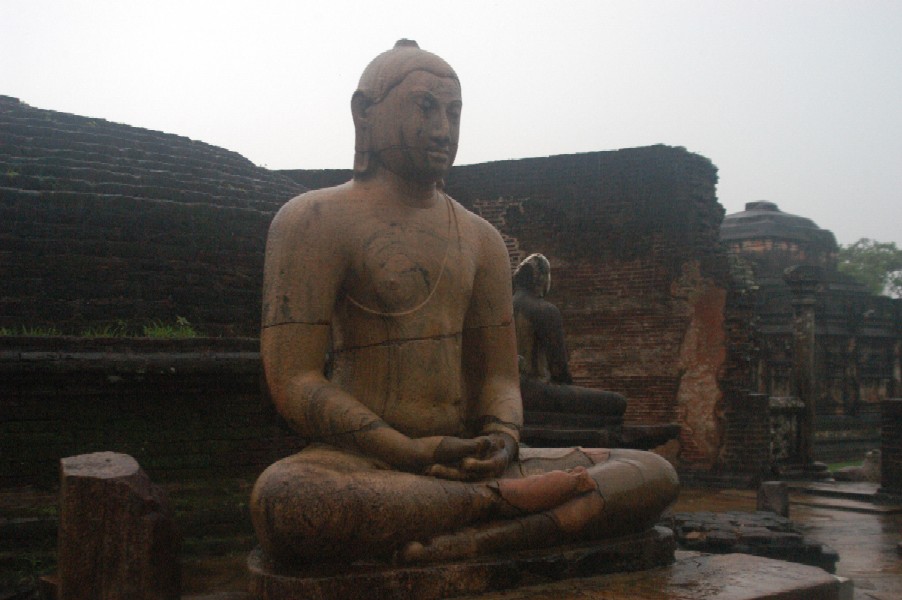 through the complex, all barefoot as well. Rob gave up and just looked from a distance. I ended up going all of the way back to the tuk-tuk in my barefeet. My socks were pretty soaked anyway. through the complex, all barefoot as well. Rob gave up and just looked from a distance. I ended up going all of the way back to the tuk-tuk in my barefeet. My socks were pretty soaked anyway.
That was the end of our visit the ruins of Polonnaruwa. We pretty much hit the highlights but it was definitely a compromised experience with the rain. We had paid our tuk-tuk driver for the day and we still had time to kill so we let him take us to a artisan shop where they sold masks, statues and furniture. We knew he would be getting a kickback but we really didn't have anything else to do. Anyway, the Brits we'd met in Nuwara Eliya had bought furniture from some artisan shop in Polonnaruwa so we figured this was probably the place. Naturally it was all set up for tourists, starting with a nice little demonstration on how they got several colors of paint from one kind of rainbow wood. When shaving were put in water it turned one color, when a base element was added (baking soda) it turned a totally different color, and when a acid element was added (lemon juice) it turned an entirely different color again. It went from orange to yellow to purple and other colors. They had a wide selection of things but much of it wasn't great quality. 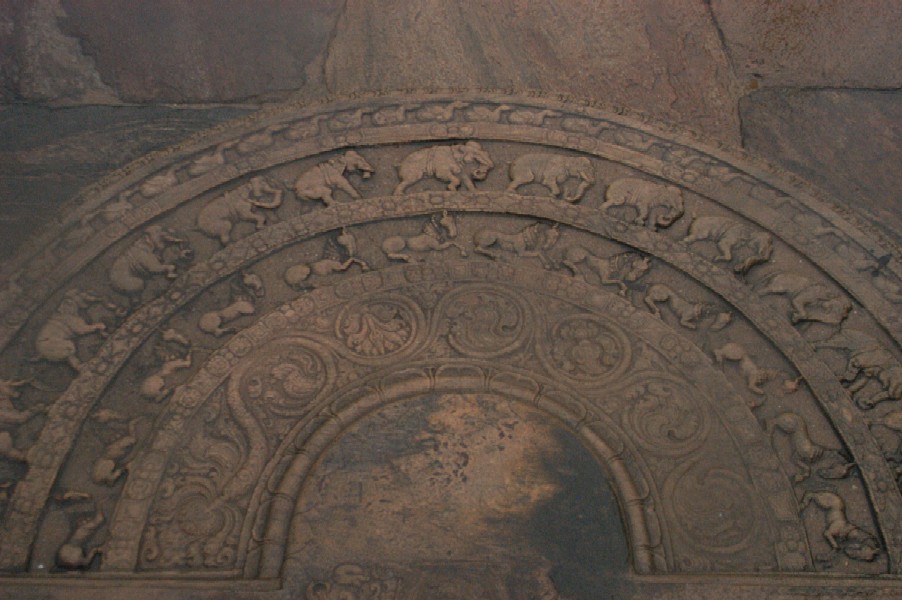 If we could have bought anything it would have been some furniture but the masks and statues were crude compared to what we had seen in Colombo. We didn't end up buying anything but our driver got a nice little snack from the shop while we looked. If we could have bought anything it would have been some furniture but the masks and statues were crude compared to what we had seen in Colombo. We didn't end up buying anything but our driver got a nice little snack from the shop while we looked.
We had our tuk-tuk driver drop us off at a hotel down the street from ours called the Rest House, a small colonial hotel on the promontory by the man-made lake. We ordered some tea and sandwiches for a late lunch while our clothes dried a bit. Even with the bad weather it was fairly relaxing, so much so that we didn't even try our hotel for dinner but decided to go back to the Rest House instead. Before going to bed we strung our clothes around the room and cranked up the fan so we didn't have sopping clothes to look forward to the next day. |

